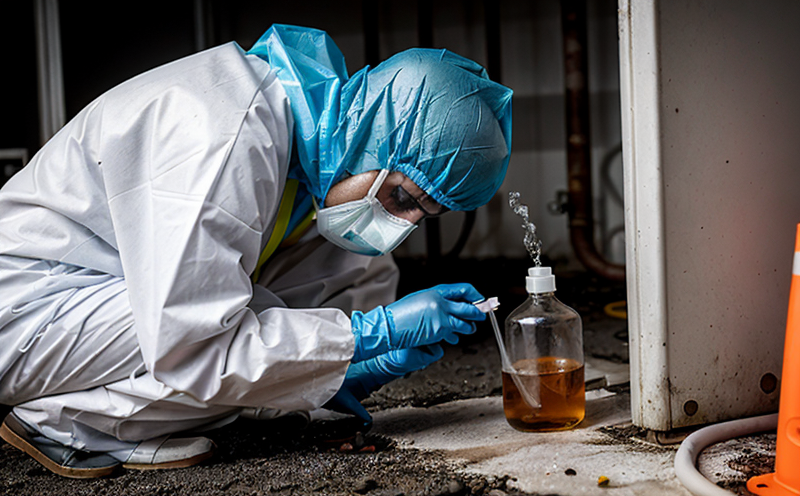ASTM F3122 Chemical and Contamination Testing of AM Metal Parts
The ASTM F3122 standard specifies procedures for chemical and contamination testing of additive manufactured (AM) metal parts. This service is critical in ensuring the quality, safety, and reliability of AM metal components used across various sectors such as aerospace, automotive, and medical devices.
ASTM F3122 addresses the need to verify that the materials and processes utilized in 3D printing do not introduce harmful contaminants or impurities into the final product. The standard provides a framework for testing different types of metal powders and their subsequent printed parts, ensuring they meet the required chemical composition and absence of hazardous substances.
The testing process under ASTM F3122 involves several key steps aimed at assessing the integrity and purity of AM metal parts. Initially, raw materials such as metal powders are evaluated for elemental composition to ensure consistency with the specified alloy. This is followed by the production of the part using an appropriate additive manufacturing technique. After fabrication, the printed part undergoes a series of chemical analyses to confirm its adherence to the intended metallurgical properties.
Contamination checks are also performed at various stages of the process. These include checking for the presence of foreign materials that could compromise the mechanical integrity or functionality of the final product. The testing methods employed under ASTM F3122 may involve spectroscopic analysis, X-ray fluorescence (XRF), and other analytical techniques to detect trace elements or impurities.
The results of these tests are crucial for manufacturers aiming to comply with industry standards and regulations. They ensure that AM metal parts meet the stringent requirements set by international standards like ISO 13906-2, which specify the chemical composition of metallic parts used in additive manufacturing processes. By adhering to ASTM F3122, businesses can demonstrate their commitment to quality control and safety, thereby enhancing customer trust and regulatory compliance.
In summary, ASTM F3122 plays a vital role in ensuring that AM metal parts are free from harmful contaminants and meet the specified chemical criteria. This service is particularly important for sectors where component integrity and performance are paramount, such as aerospace and medical device manufacturing.
Applied Standards
The ASTM F3122 standard integrates various testing methods to ensure that additive manufactured metal parts meet the specified chemical composition and absence of contaminants. This includes:
- Spectroscopic Analysis: Used to determine the elemental composition of raw materials and final products.
- X-ray Fluorescence (XRF): For rapid, non-destructive analysis of surface elements in metal parts.
- Inductively Coupled Plasma Mass Spectrometry (ICP-MS): Provides precise quantification of trace elements in the materials used for AM processes.
- Electrochemical Testing: To assess corrosion resistance and potential galvanic coupling effects between different metals or alloys.
The ASTM F3122 standard also recommends the use of specific test methods from other recognized standards like ISO 13906-2, which outline the chemical composition requirements for metallic parts used in additive manufacturing. Compliance with these standards ensures that AM metal parts are not only free from harmful contaminants but also meet the performance criteria set by industry regulations.
By adhering to these stringent testing protocols, manufacturers can ensure their products comply with international best practices and regulatory requirements, thereby enhancing product quality and customer trust.
Benefits
Implementing ASTM F3122 chemical and contamination testing offers numerous benefits for businesses involved in additive manufacturing. These include:
- Enhanced Product Quality: Ensures that AM metal parts meet the highest quality standards, reducing the risk of defects and failures.
- Improved Regulatory Compliance: Helps manufacturers comply with international standards and regulations, facilitating smoother market entry and operations in various regions.
- Increased Customer Trust: By demonstrating adherence to rigorous testing protocols, companies can build stronger relationships with clients who demand high-quality products.
- Cost Efficiency: Early detection of defects or contaminants through ASTM F3122 testing can save costs associated with rework and scrap.
- Innovation Support: This service supports R&D efforts by providing data that can be used to refine manufacturing processes and improve product performance.
- Achieving Sustainability Goals: By ensuring the absence of harmful contaminants, manufacturers contribute to sustainable practices in the industry.
The benefits extend beyond individual companies to positively impact entire supply chains. ASTM F3122 testing ensures that all parts used in additive manufacturing processes are of high quality and meet regulatory standards, fostering a more reliable and trustworthy ecosystem for AM metal parts production.
Use Cases and Application Examples
The application of ASTM F3122 chemical and contamination testing is extensive across various industries where the integrity and safety of additive manufactured metal parts are critical. Here are some real-world use cases:
- Aerospace Industry: Ensuring that AM titanium parts used in aircraft engines or structural components meet stringent quality standards.
- Medical Device Manufacturing: Verifying the purity of stainless steel or cobalt-chromium alloys for prosthetic implants to prevent adverse reactions or infections.
- Automotive Sector: Testing AM aluminum parts used in car frames or engine components to ensure they meet durability and safety requirements.
- Military Applications: Guaranteeing that AM steel parts used in military equipment are free from contaminants that could affect performance under extreme conditions.
In each of these sectors, the absence of harmful contaminants is crucial for ensuring the longevity and reliability of the final product. ASTM F3122 testing provides a robust framework to achieve this goal.
Additionally, R&D engineers can leverage the data obtained from ASTM F3122 testing to optimize manufacturing processes, refine alloy compositions, and improve the overall performance of AM metal parts. This service is an invaluable tool for manufacturers looking to stay ahead in their respective industries by adhering to the highest quality standards.





